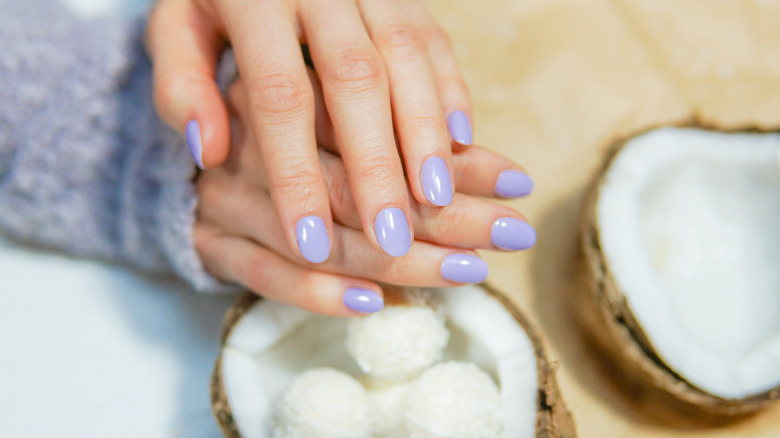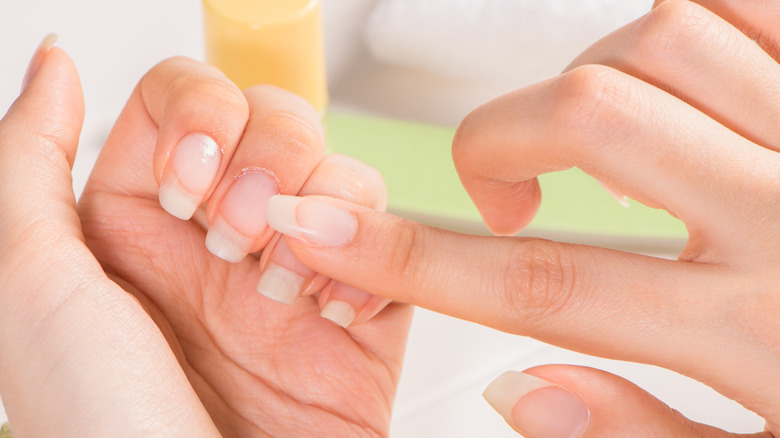How To Bring Coconut Oil Into Your Nailcare Routine
You've probably already heard that coconut oil can have some serious body benefits. Coconut oil has uses in everything from hair treatments and oil pulling to creating a natural makeup remover — but did you know it also has its uses in the nail world? Yep, the product that seemingly does it all has also made its way into our manicures and pedicures.
Why? Well, coconut oil has a host of big benefits when applied to the hands and feet. One of the biggies is that it can actually strengthen your nails to stop things like unsightly splits and peels. "Coconut oil is great for treating brittle and cracked nails as well as damaged cuticles because of its moisturizing properties," board-certified dermatologist Orit Markowitz told Byrdie. It's also a great moisturizer for dry hands and feet. "Coconut oil can help with cracks and water loss in the top layer of the skin by providing key essential fatty lipids. These lipids improve the barrier function of the skin, allowing it to feel supple and hydrated as a result," board-certified dermatologist Dr. Beth Goldstein explained to Healthline. But that's not all. It can also help repair damaged cuticles and hangnails, as well as prevent unsightly nail ridges.
But how exactly do you bring coconut oil into your nailcare routine? And when and where do you apply it? We're answering all those questions and more as we break it down, step by step.
Finish up your manicure (or with your hands)
If you're applying coconut oil as part of a manicure routine, you'll want to do it as the final step in your nail routine (whatever that may be). That means after your nail polish (if you're wearing any) is totally dry or cured and you've finished everything you're doing to your hands and feet. You'll want to make sure applying coconut oil is the absolute last thing you do, because you don't want to have to wash or accidentally wipe it all off once you start using your hands again. Because of that, it's a good idea to apply coconut oil to your hands or feet at night right before bed when you know you won't have to use them for a while.
As for the best coconut oil to try for your nails and cuticles? Unrefined coconut oil is processed less than virgin coconut oil, so it may be a better fit for a lot of people because it's slightly gentler than virgin. However, because virgin is a little more processed, some people prefer its scent.
Dry and clean your hands and feet
Once you've finished up your manicure, pedicure, or whatever it is you're doing, give your hands and feet a good wash with soap so that they're clean and ready to go. As well as ensuring your nails are ready to get moisturized, this will also remove any dirt, so you're minimizing the chances of rubbing bacteria into your nails.
You'll then want to make sure both your hands and feet are totally dry using a towel. This step is particularly important if you're using coconut oil not just for its moisturizing properties, but also for its benefits in treating nail fungus. That's because you want to make sure you're nor spreading or agitating any infections, and creating an environment that's as sterile as possible will do that.
Apply the coconut oil to your nails and let it penetrate
Next, grab your coconut oil and get ready to massage it onto the cuticle as well as your fingernails and toenails. How much you need for each nail will depend on its size as, of course, larger nails will need a little more product. Use enough to coat each one without being wasteful.
Skyy Hadley, a celebrity manicurist and nail spa owner, recommended to Byrdie rubbing the coconut oil straight onto the cuticles to moisturize them or on the nails to strengthen them. Then leave it there to soak in. How long you should leave the coconut oil on will be totally dependent on how much time you have, though Hadley suggested leaving it for a minimum of 30 minutes. If you can, though, leaving it on overnight is more likely to give you the best results. "Doing this will help strengthen your cuticles, moisturize the skin around your nails, and get rid of hangnails," Hadley shared.
If you're applying coconut oil to infected nails, Hadley recommended a slightly different approach. "Massage the oil gently on the affected nail area once it's been thoroughly cleaned and dried. Repeating this twice a day is the most sufficient method until the fungus goes away," she said. We'd recommend treating your infected nail or nails first, then washing your hands before touching any others to avoid spreading the infection. Always seek medical attention if you have painful infected nails.
Throw on moisture gloves or socks
If you're really looking to hold in all that coconut oil moisture, try putting on some moisture socks or gloves after applying your coconut oil. For those unfamiliar, moisturizing gloves and socks are designed to hold and lock in moisture to combat dry skin. Not only will this help to keep your coconut oil on your fingers and toes, but you'll also be getting the added benefits of moisturized hands and feet while you sleep. Moisturizing gloves come in a range of different variations, including reusable and non-reusable, so which variety you go for is totally up to you.
"Nighttime is our time to reset and we're sleeping anyways, so why not treat our hands while we are at it?" Christina Uzzardi, esthetician and founder of Cheeks+Co, told Real Simple. And we couldn't agree more. "Our hands get regular UV exposure and are the first to show signs of damage so it's smart and effective to give them the TLC they deserve," she added of the benefits.
If you're bringing coconut oil into your nail routine to keep your nails moisturized, you can repeat these steps as many times as you like and even apply the product daily before bed. If you're more focused on strengthening your nails or treating hangnails, Skyy Hadley recommended to Byrdie applying the oil and repeating these steps between twice and four times a week.
Remove the excess coconut oil (if you need to)
There's no real time limit for how long coconut oil should be left on or around your nails. Think of it like a body or hand moisturizer, as it will, over time, simply soak into the skin and keep it moisturized. However, if your 30 minutes are up and you've got places to be, you may prefer to remove the excess coconut oil. That's because coconut oil has been known to stain some fabrics, so you may not want to be walking around with it on your person — particularly your hands.
Because coconut oil seals moisture in the skin, you may find it doesn't simply wash away with water, especially if you've been liberal with your application. Instead, blotting your hands and feet with a towel or a dry cloth may help absorb some of the oil. Equally, blotting paper can also be used to help remove any excess oil from your hands and feet.





